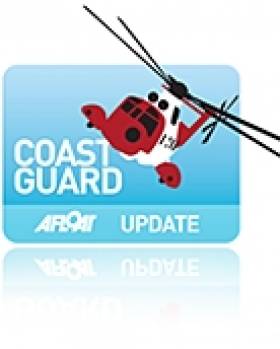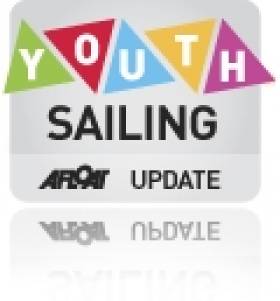Displaying items by tag: Schull
#WaterfrontProperty - If stunning yet tranquil views over Galway Bay to the Clare hills beyond appeal, an exclusive apartment development in Salthill might be your next home.
As the Galway Advertiser reports, all 12 apartments in Gentian Villas overlook the bay from an elevated site adjacent of Galway Golf Club and just a short walk from Salthill's famed promenade - and a stroll again into the heart of the City of the Tribes.
And extensive renovations inside the twi-bed owner-occupied home on offer make its guide price of €195,000 a real bargain for the quality of life you'll get from living there. The Advertiser has more HERE.
Meanwhile, for those in need of a little more room, this terraced home outside Schull in West Cork could be just the ticket.
7 The Coastguard not only comes with much sought-after sea views, but also use of a shared slipway at the private development - perfect for boat owners in what's one of the region's most popular cruising and racing destinations.
Schull Alumni Win ITRA Trials for the ISAF Team Racing Worlds
#teamrace – The Schull Alumni team showed themselves to be the 'in form' team, confirming their ITRA Irish team racing Champion status.
The ISAF Team Racing World Championship is the ultimate test of the three boat versus three boat format. The Irish Team Racing Association ran trials on 14th February to select the Irish representatives. The event was sailed in light airs within Dun Laoghaire Harbour with five teams competing in the double round robin. Royal St George Yacht Club's excellent Fireflies provided the ideal platform, as identical boats will be used in the Worlds on Rutland Water, UK.
In the first match Alumni were drawn against rivals George Knights as youth and speed took on the experience and cunning of the Knights. It was cut and thrust from the warning signal with no quarter asked for or given. The umpires were kept busy answering protests. Schull got the upper hand and retained control sailing faster to take the first match in the rubber. The second match saw the George Knights start strongly but were reeled in by Schull's superior speed. It was all to play for down the run but Knights held onto the lead with a 1,4-5. Mark 4 saw 4 boats frenetically tacking and gybing as Schull tried to get into a winning combination. The George held the combination with last place swapping between the teams but a misjudgement by Knights on the finish line saw Schull sneak the win. The George didn't drop another match (6 wins) and Schull (7 wins) fell only to Aidan McLaverty's Hoop Dream, who took third place with 4 wins.
ITRA will recommend to the ISA that Alumni and Knights be selected as IRL1 and IRL2 for the ISAF Team Racing World Championships and if a third place is offered to Ireland Hoops will be selected as IRL3.
Thanks to Gordon Davies for organising the event, the RStGYC for providing the facilities and the race and umpire teams for supporting an enjoyable event.
Schull Alumni:
Mark Hassett, Fionn Lyden, Oisin O'Driscoll, Liam Manning, Ellen O'Regan, Katie Moynihan
George Knights:
John Sheehy, Rebecca Killian, Nick Smyth, Rachel Guy, Ger Owens, Maeve Judge
Hoops:
Aidan McLaverty, Sonia Minihane, William Clarke, Madoline O' Connell, Ross Murray, Niamh Connoly
For more information contact Gordon Davies (Hon Sec ITRA) 086 150 1220
Team Racing Championships Completes 170 Races To Crown Local Champions in Schull, West Cork
#teamracing – The Irish Team Racing Nationals were held over the 8th and 9th November 2014 in Schull, West Cork. Following a great weekend, 170 races using 4 flights (24 boats) 21 teams competed for the National championships. A Schull Alumni team won the national title and comprised Mark Hassett with crew Liam Manning, Fionn Lyden with crew Michelle Morgan and Oisin O'Driscoll with crew Katie Moynihan.
Three teams from the UK travelled across to be part of a sunny, 10 to 15 knots from the NW weekend, with the top 18 Irish teams.
For the first round, teams were seeded into three leagues of seven teams, after 63 races the top three teams from each league were placed in the Gold league the next two teams from each league placed in the Silver league and the last two from each league placed in the Bronze league.
For the second round, Nine teams sailed in the Gold league to seed the teams for the quarter finals, with the Silver and Bronze doing the same to seed the teams for the semi-finals.
Following the Quarter finals four teams came out on top, two Irish and two English
Oxford & Cambridge
Schull Alumni
Wessex Exempt
Gladiators
Following very close semi finals Oxford & Cambridge and Wessex Exempt went through to the Final with Schull Alumni and Gladiators paired off to fight it out for the National Champions
Wessex Exempt took the title and Schull Alumni the National Champions
Schull Alumni team
Mark Hassett with crew Liam Manning
Fionn Lyden with crew Michelle Morgan
Oisin O'Driscoll with crew Katie Moynihan
British Crews Eye Up Irish Team Racing Nationals At Schull
#teamrace– The Irish Team Racing Association 2014 National Championships will be sailed in Schull on 8th-9th November. The event will be run by the Fastnet Marine and Outdoor Education Centre using their fleet of TR3.6 boats.
Several British teams have expressed their intention to make the trip to West Cork.
There will be a Youth prizes, with a separate knock-out stage if more than 3 Youth teams enter.
Youth is defined as under 18 on December 2014 - so that sailors in this section will meet the age requirements for the 2015 Worlds
In order to provide the best facilities possible, and to ensure that we have invited enough personnel, including umpires please return the attached pre-entry form with the required deposit before Monday 6th October. Only teams that have pre-entered by that ate will be guaranteed entry to the championships.
One Body Recovered, Two Rescued Alive in West Cork Yachting Accident
#westcorkyacht – Two people have been found alive and one body has been recovered after a boating accident off West Cork this morning.
Our photo from the scene taken at dawn this morning show the rescue operation underway with the Coastguard helicopter landing on Horse island, a well known boating spot.
The yacht was discovered shortly after first light this morning, an RNLI spokeswoman said.
RTE News reports the three crew were in a 20-foot yacht that left Schull harbour yesterday afternoon but had not returned by 7pm as expected.
The alarm was raised by a friend who was due to meet them on their return and an air and sea search operation began.
The discovery came after 12 hour search operation when a seven metre yacht (21ft) was reported overdue and missing in Roaringwater Bay in Schull.
A 76-year-old man and the woman, who is in her 60s, were found on a small island known as Castle Island in Schull harbour at 6.15am this morning.
A man's body was found later and is being brought to shore.
They were in need of medical attention and suffering the effects of hypothermia.
The Shannon based Helicopter Rescue 117 lifted the casualties and took them to Baltimore for further medical attention.

Baltimore lifeboat and the Coast Guard Helicopter located the dinghy and two crew on a small island known as Castle Island in Schull harbour at 6.15am this morning. Photo: Judy McGrath
They indicated to their rescuers that the third man had been trying to swim the 100m to shore along with them when they lost contact with him.
The Irish Independent reports the yacht was a Drascombe Lugger, about 20ft long, which was found upturned about one and a half miles from shore near Castle Island. The boats are popular in this area ideal for coastal cruising and conditions in more sheltered parts of the bay are considered ideal for vessels of this kind.
Sources say formal identification of the body and confirmation that the remains are those of the missing sailor will take some time.
Additional report from RNLI Baltimore
Baltimore Lifeboats have been involved in a major search and rescue operation in Roaring Water Bay. Three people were reported missing when a small open sailing boat ( a Drascombe Lugger) failed to return to Schull as planned at 7pm. The Baltimore lifeboats were alerted at 9:14pm on Wednesday 13 August. They immediately began a search of the area between Long Island in the West and Horse Island in the East and extending South through Roaring Water Bay. The lifeboats continued searching as darkness fell until the search was stood down after midnight. The search was recommenced at 5:30 am this morning 14 August. Two people were found by Schull Community Rescue on the NW corner of Castle Island at 6:15 this morning. They were a man in his 70's and a woman in her 60's, both from the UK. Inshore lifeboat Helm John Kearney and crew Ryan O'Mahony carried out a medical assessment of the man and woman who had scrambled ashore the previous evening after their boat had capsized, and then the Shannon based Helicopter Rescue 117 took them to Baltimore for further medical attention. The upturned boat was found aground on the nearby Carthy Islands.
Several hours later inshore lifeboat Helm Youen Jacob with crew John Kearney and Ryan O'Mahony spotted a life jacket in the water North of Sherkin Island. The body of the missing man was recovered at 8:15 approx. The man was taken to the station at Bullpoint where he was pronounced dead by RNLI Medical Advisor Dr Don Creagh. Sergeant Tony McCarthy and Garda Mairtín Ashe attended the scene and supervised removal to CUH for post mortem.
The search and rescue operation was made possible by the RNLI Baltimore volunteer crews and shore crews.
Yesterday evening on board the all weather lifeboat were Coxswain Kieran Cotter, Mechanic Brian McSweeney and crew John O'Flynn, Jerry Smith, Eoin Ryan, Don O'Donovan and Diarmuid Collins. Onboard the inshore lifeboat were Helm Kieran Collins, Micheál Cottrell and Tadhg Collins.
Today onboard the all weather lifeboat were; Coxswain Pat Collins, Mechanic Sean McCarthy, Shane McSweeney, Diarmuid Collins, John O'Flynn,Tadhg Collins. On board the inshore lifeboat were Helm Youen Jacob, John Kearney and Ryan O'Mahony.
The Sailing & Boating Wonders of Ireland's West Cork Coast
The sailing paradise of West Cork on Ireland's south-west coast is at its best right now, and the south coast fleets are already heading that way for the traditional West Cork regattas in August. WM Nixon reflects on the magic sailing region of West Cork.
West Cork is as much of a frame of mind as a specific place. Officially, we might suppose it to extend all the way along the Rebel County's coast from the Old Head of Kinsale to Dursey Island away in the far nor'west, up at the north side of the wide entrance to Bantry Bay. But this doesn't necessarily mean that all the folk in the hinterland north of this coastline see themselves as being in West Cork.
As for boat people, our limits are much more narrowly defined. If you're afloat down there, West Cork is that sublime but compact bit of coastline between Galley Head and Mizen Head, just 38 miles as the gannet flies. It's the ultimate lotus land, with an interesting scattering of islands, blessed moreover with an abundance of sheltered natural harbours each with its own port town or village vying with its neighbours in colourful character. And visible from much of it is the Fastnet Rock, mysteriously a place of the remotest ocean despite being only a matter of four miles from the nearest land at Cape Clear.
In this magic land, the local mini-capital is of course Skibbereen, the very essence of a rural market town. But on the coast, the very different harbours of Schull, Baltimore, and sometimes even Glandore have been seen over the years as the sailors' capital of West Cork. Recently, however, it is Baltimore which has gone from strength to strength to affirm its position as the sailing capital of the southwest, and spending a June night there as summer settled comfortably over Munster reinforced the impression of its pre-eminence.
We were on a bit of a land cruise, so the bed for the night was in the Waterfront, the hotel where Room 12 is just about as near to the beating heart of Baltimore as you can get. Aboard a cruiser in Baltimore, you can enjoy that splendid isolation which a boat so easily confers. But in Room 12 on top of the Waterfront's northwest corner above the square, the busy life of the little port town bubbles about you, and the views across to Sherkin Island and over the country to Mount Gabriel get even more perfect with the approach of sunset.
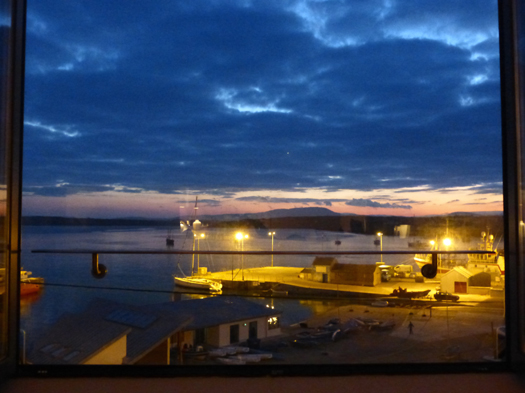
The view from Room 12 at the Waterfront in Baltimore. The sun has set beyond Mount Gabriel, but somebody is busy launching a newly-arrived RIB by floodlight, and the buzz from the square below is still rising. Photo: W M Nixon
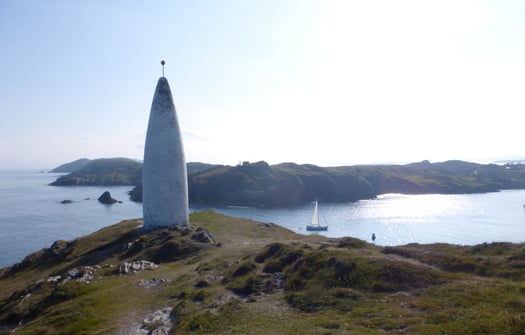
It has to be one of the best arrivals in world sailing. A cruiser enters Baltimore beneath the Baltimore Beacon, aka Lot's Wife. Photo: W M Nixon
It was fifty years ago when I first sailed in to Baltimore, coming in from the west on a round Ireland cruise, and entering port close under the beacon – Lot's Wife they call it – to find a quiet little place which showed some signs of a former prosperity, and hinted at better times to come. Back in 1964, it still had its railway station, but the West Cork Line was in its final year and was soon to be totally closed. Before that happened, later that summer when Baltimore Sailing Club hosted Dinghy Week for the Irish Dinghy Racing Association, the Firefly Class in Dun Laoghaire – mostly university boats – had been able to have a Tuesday night race. Then they'd towed their boats into Dun Laoghaire station on the launching trolleys, put them onto a CIE flat truck, and found them on Friday night safely delivered by rail the entire way to West Cork, offloaded ready at the harbourside station in Baltimore, and waiting for the arrival of thirsty crews keen for a bit of sport.
Mostly, they'd got themselves there by overloading some little car belonging to somebody or other's mother, so the fact that they disdained to use the railway themselves would help to explain why such a charming amenity was doomed. Since then, of course, Baltimore Railway Station from 1969 until recently had become Ireland's first Glenans base. But life moves on, the Glenans model doesn't seem to work any more in Ireland, so now the former station is for sale by the powers-that-be, and there are ructions being raised about it all which should keep everybody nicely exercised through the rest of the summer.
It was another French import which currently sets the pace in Baltimore. Around 1980 a young Breton fisherman, Youen Jacob, came into the harbour, and in time he settled there. To say that Youen Jacob has played a major role in Baltimore life is understating the case. It is he and his family who have developed the Waterfront – quite a challenge in somewhere as conservative as West Cork – and with Youen Jnr's Jolie Brise restaurant and guest house beside it to provide an alternative aspect of good Breton cuisine, the Jacob family's establishments have given a healthy new configuration to Baltimore's miniature harbourside square, and have settled in so well you could be forgiven for thinking the little town was built around them.
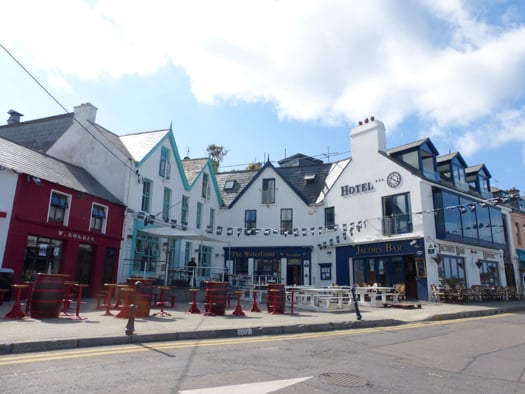
The Waterfront (right) and Jolie Brise at the south side of the mini-square in Baltimore bring a welcome breath of Brittany to West Cork. Photo: W M Nixon
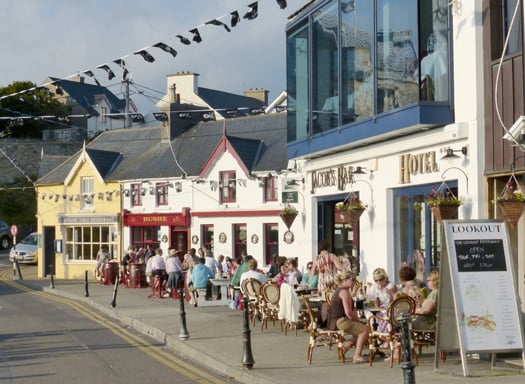
It's party time in Baltimore. The al fresco lifestyle is expected in West Cork in summer. Photo: W M Nixon
There are times when you'd understandably think this is the hub of the maritime universe, and why not? But if, during a quiet cruise, you think you might find it too hectic at night when the joint really is jumping, the sensible thing is to call by at lunchtime when everybody is out at the islands and Baltimore is refreshed and catching its breath for the next night's partying. Then in the evening, you can pop over to Sherkin Island where peace will reign while Baltimore ramps up the socializing.
Up in our eyrie above the square, we savoured the life of this busy little port. It's not quite a 24-hour town, but late at night boats were still being launched by floodlight, and conviviality continued in the square. Finally, peace descended, and though most folk were slow to stir early in the morning, the first ferries were coming in, and a workboat headed out for the islands, going past Graham Bailey's Peel Castle, the remarkable bisquine-rigged variation on a 50ft 1929-built Cornish lugger which is seen at her best on her mooring in Baltimore harbour. This is only right and proper, as the restoration and re-configuration of Peel Castle took place nearby, just up the Ilen River at one of the boatyards at Oldcourt.
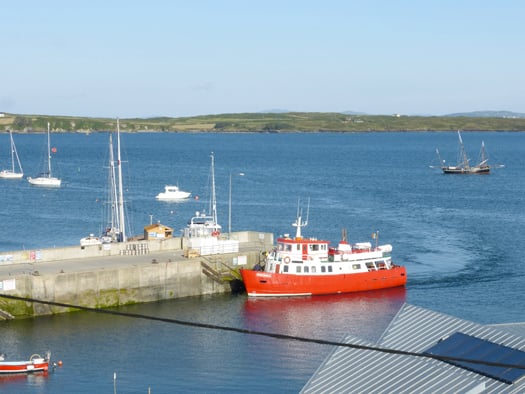
Good morning Baltimore, how are you? The first ferry arrives in from Sherkin Island. Photo: W M Nixon
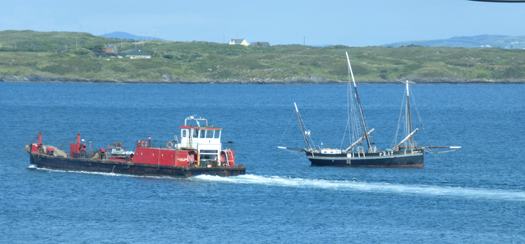
Getting the day's job started. A workboat heads out towards Sherkin past Graham Bailey's distinctive Peel Castle. Photo: W M Nixon

Peel Castle in all her glory in the middle of Baltimore Harbour. Restoring this 1929-built 50ft Cornish fishing boat and giving her a bisquine rig took Graham Bailey eight years of dedicated work at Oldcourt. Photo: W M Nixon
Another Baltimore revival which gets our approval is the restoration of the castle right in the middle of town, the "tigh mor" which presumably gives the place its name. We suffer from a widespread ruins overload in Ireland, so it's refreshing to find that somebody upped and took action, brining a ruin back to life and giving Baltimore a very effective signature focal point with a useful function. You could do the same to good effect at Dromineer on Lough Derg, where the ruined castle is an eyesore.
But you don't even have to leave the Baltimore area for a worthwhile restoration project, as just across the harbour beside the pier on Sherkin is the roofless ruin of the 15th Century Franciscan friary which we know looks much better with its roof back on, even if it has been missing since the 1770s.
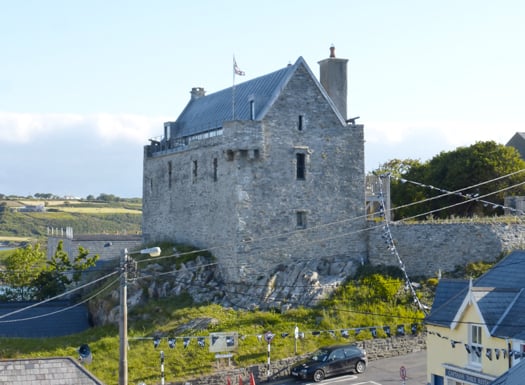
The restoration of the castle at Baltimore has given welcome and useful new life to a former ruin. Photo: W M Nixon
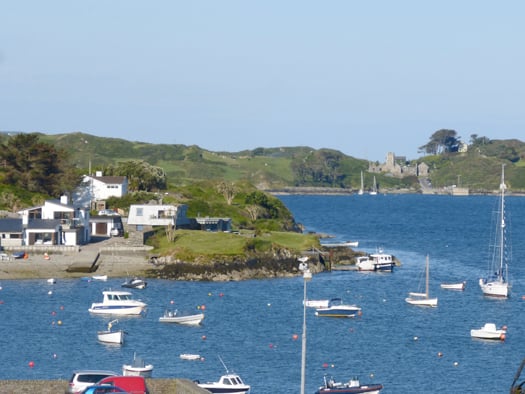
The Cove on the south side of Baltimore Harbour has some very desirable real estate. Photo: W M Nixon
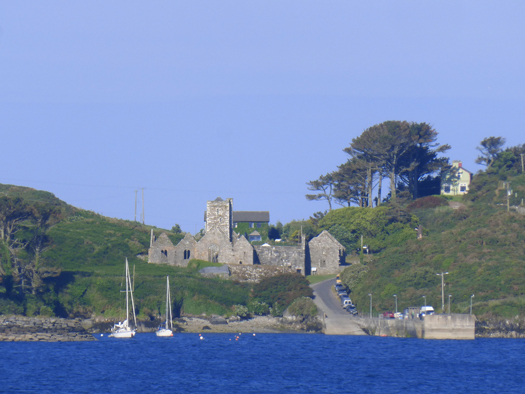
Thanks to its use as a film set in 1973, we know that the friary on Skerkin Island looks much better with it roof in place. Photo: W M Nixon
We know this because, in 1973, the makers of a TV film managed to get permission from the OPW to put a temporary but very convincing roof in place, and it looked so utterly right. The film was the unfairly forgotten Catholics, based on the novel of the same name by Belfast-born Brian Moore, and memorably starring Trevor Howard as the troubled Father Abbot. Even in this usually overlong blog, there isn't space to go into the details of the story, but it's worth viewing Catholics at the very least to see how well Sherkin friary looks with a roof. Alas, when filming was done the production company religiously (how else?) adhered to the OPW's demands to return the very attractive little old building to its ruinous state, and there it sadly sits.
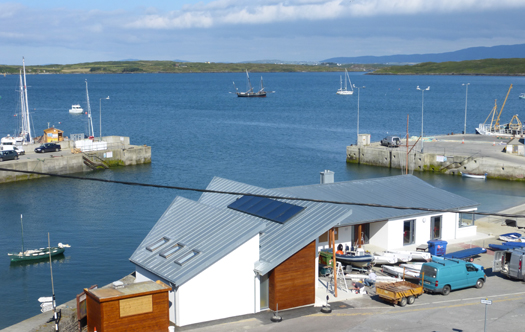
This year's work on Baltimore Sailing Club has made it even more of a local asset. Photo: W M Nixon
But as regular readers of Afloat.ie will know, other refurbishment and extension work has been under way in Baltimore, with the Sailing Club in fine fettle in its extended premises which look so well you'd think it's all new. It's certainly all of a piece with Baltimore's vitality, which contrasts with other little West Cork ports. In Baltimore, the key to it all is the fact that the Waterfront gallantly stays open all year round. But at present in Schull and Glandore, the main hotels don't even open in summer.
Doubtless in time, and sooner rather than later, both establishments will be brought back to life. But for people genuinely cruising, the absence of a hotel or two doesn't matter that much in an area where the abundance of cruising options and hospitable pubs with good food is almost bewildering. And around Baltimore in particular, there's always something going on.
The wholesome 1893-built cutter Eva (later known as Guillemot) was restored at Oldcourt, which is only a few miles from her birthplace 121 years ago on the Baltimore waterfront. Brian Marten's project to have Eva re-born and continue as Guillemot has come to a successful conclusion after she went through several vicissitudes before he happened upon her, but a visit to Oldcourt will reveal many other boat restoration, re-build and re-birth projects at various stages, including some which - as our accountancy friends would insist on putting it - are no longer going forward.
Be warned, however, that any visit to Oldcourt in any capacity whatever is likely to take longer than you expect, as there's simply so much to see. And they're at every stage, from projects just starting, through projects stalled, to projects nearing completion, while inspiration was being provided by a visiting boat, Darryl Hughes' immaculately-restored 1937 43ft Tyrrell ketch Maybird, which was berthed for a while at Oldcourt to let boatbuilder John Hegarty take off measurements in order to build a traditional clinker dinghy which will fit on board.
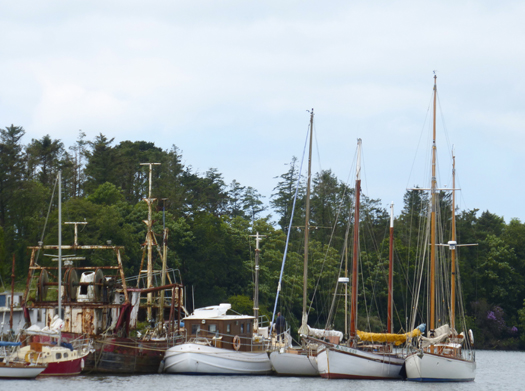
Boats in a row at Oldcourt. The further from the quay, the more ready for sea you are. Furthest out is the 1937 Tyrrell ketch Maybird, with which owner Darryl Hughes regularly attends the annual Yeats Summer School in Sligo. He's the only participant to arrive by sea, and he lives on board at the pontoon in Sligo during the Yeats festival. Photo: W M Nixon
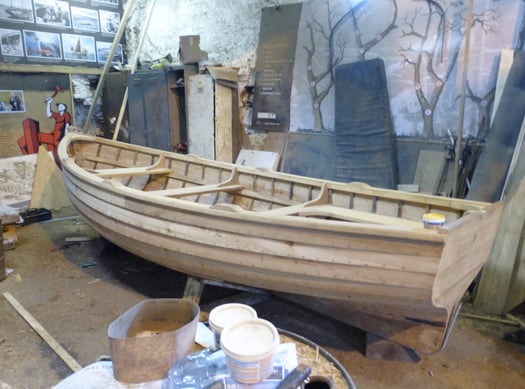
A new traditional clinker dinghy, built by John Hegarty of Oldcourt, awaits her first coast of varnish. Photo: W M Nixon
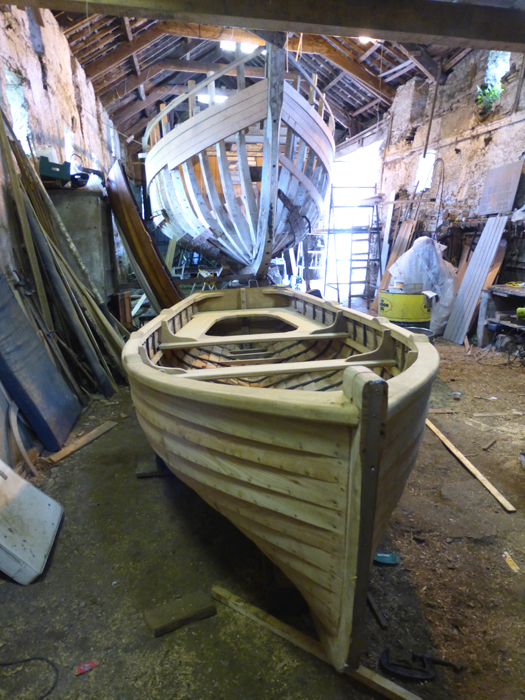
The new dinghy shares space with Conor O'Brien's Ilen, which continues to be a major work in progress. Photo: W M Nixon
Just to show what the result will be like, there was another recently-completed Hegarty dinghy in the Ilen shed, and very well it looked too. As for the restoration of Conor O'Brien's Ilen herself, that can best be described as ongoing. It has become such an absorbing task that the restoration process might best be thought of as an end in itself. Trying to work out what could most usefully be done with this hefty big lump of a boat if she ever is restored to seagoing condition is something which will require many brainstorming sessions, but it surely doesn't need to be considered in too much detail just yet.
The problem with the Ilen is she's too small for some things, and too big for others. She's of the same sort of in-between size which made the first Asgard of limited use as an official sail training vessel. Asgard was fine for teaching young people to sail, but she was simply too small to keep up with the tall ships which also completely overshadowed her in port, where Ireland's little ketch also failed to provide the necessary space and impressive setting for entertaining local bigwigs.
Manageability is the keynote to successful boat restorations. But Oldcourt is such a maritime universe that it can provide examples of what you'd think might have been eminently manageable restoration projects, yet they've ground to a halt. One such is Englyn, the creme de la crème of the boats amateur-designed by Harrison Butler, the English opthalmologist. In the 1930s, he was designing boats which successfully anticipated the highly-regarded designs of Lyle Hess more than forty years later, and the 26ft 6ins Englyn was so highly thought of by cruising guru Eric Hiscock that he included the design in his seminal book Cruising Under Sail, first published 1950.
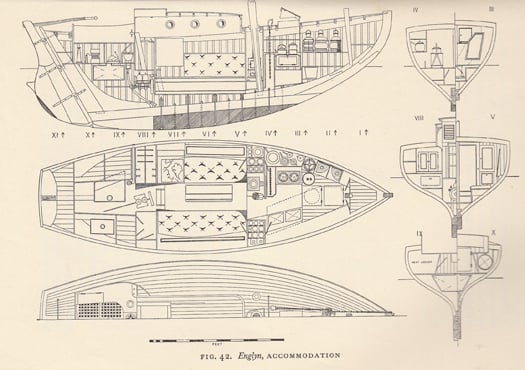
Plans of the Harrison Butler-designed Englyn, as featured in Eric Hiscock's Cruising Under Sail.
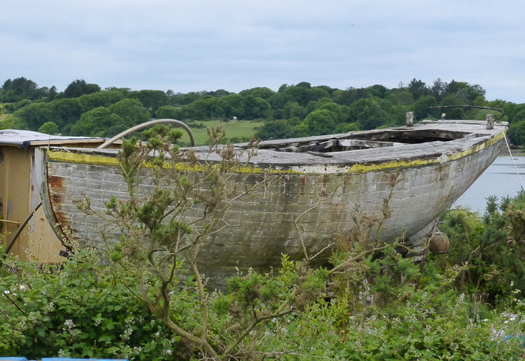
A little boat that may have missed the boat. Englyn as she is today. Photo: W M Nixon
If anything, the designs of Harrison Butler are more cherished than ever, and in this blog on May 10th we featured photos of the Harrison Butler Khamseen class cutter which ace boatbuilder Steve Morris is creating near Kilrush. It's heart-breaking to see the lines of Steve's healthy boat palely reflected in the weather-beaten remains of Englyn as she is today. But sometimes boats really can be brought back from the near-dead, and at the two-day Glandore Classic Boat Summer School in mid-July, the entire Sunday afternoon was given over to presentations about boats in various stages of restoration in and around Oldcourt.
Despite some unpleasantnesses visited upon it by the lingering death of the Celtic Tiger, Glandore gallantly soldiers on. Glandore Harbour Yacht Club's new headquarters in a cleverly rebuilt two-storey cottage up a side street (the only side street, as it happens) is appropriate to the good taste which prevails in this sweet place, whose name in Irish can mean either the golden harbour, or the harbour of the oaks - either will do very nicely.
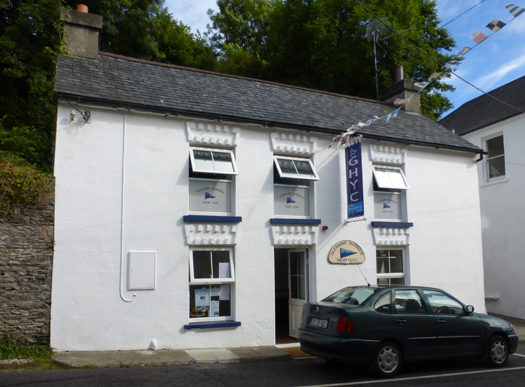
Glandore Harbour YC's clubhouse is now this cleverly re-built two-storey cottage beside the harbour. Photo: W M Nixon

The outboard dinghies waiting at the pontoon at Glandore Pier give a good indication of the number of boats based in Glandore and across the harbour at Union Hall. Photo: W M Nixon
The Summer School packed in an extraordinary variety of topics, and even this blogger was wheeled out to develop his thesis based around the ambiguous question: Why shouldn't the Irish be a seafaring people? Don't worry, for those who missed it, we'll push it out again here some time in the depth of winter. But we cannot hope to convey the full wonder of the best event in the Summer School, the question-and-answer session between ocean voyaging and offshore racing legend Don Street and his son Richard.
The old boy hasn't half been around. And if at some time your only experience of Don Street has been a high-pitched New England rant about some iniquity of modern yachting (fibreglass dismissed as "frozen snot", for instance) it's my happy duty to assure you that, as he delved into his extraordinary memories, the pitch of Don Street's distinctive voice became deeper and more resonant, until by the time he concluded all too early, we could have been listening to Captain Ahab himself.
From such a treasure trove of recollection, there were many gems, perhaps the best being about how he came to make his profession in writing about the sea and sailing. In his early days in the Caribbean before he'd put pen to paper, on one run ashore Don and his shipmates met up with Nobel Laureate John Steinbeck, and they'd a convivial time together. Later, heading back along the islands, they'd another dinner with the great writer, and during yarning at table, Don's shipmates insisted he'd so many good stories to tell that he should write them down.
"But I don't know how to spell, and I know nothing about grammar" complained Don.
"But you've a story to tell" said Steinbeck, "and you tell it well. Just you write it down, and the editors will sort out the spelling and the punctuation and the grammar. That's their job."
God be with the days......
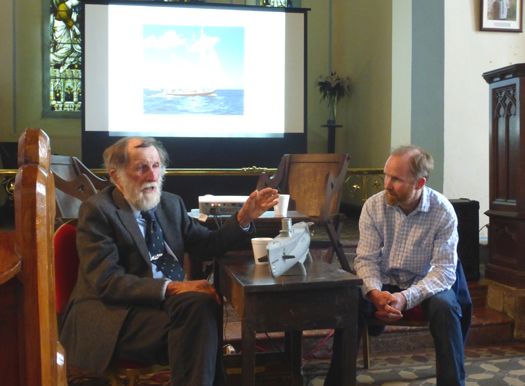
The old man of the sea – Don Street's reminiscences were the highlight of this year's Glandore Classic Boat Summer School. The school sessions were held in the harbourside church, and Don is seen here with his son Richard while he recalls his days in submarines in the US Navy. On the screen is his legendary 1905-built yawl Iolaire, in which he cruised the Caribbean and crossed the Atlantic. Photo: W M Nixon
Top Marks to Schull in School Team Racing Nationals
#schoolsailing – Local team 'Schull Sharks' were winners of the Irish Schools Sailing Association Team Racing National Championships held in Schull Bay, West Cork from May 3–4. UK visiitng team PBC were second but in a show of strength for West Cork team racing a further two Schull teams took third and fourth. Rathdown Girls School from Dun Laoghaire were next followed by Mt. Anville, Gonzaga and then Blackrock College.
Full results are attached for download as a pdf file.
Although it was hoped this year to host the Nationals in Dublin, a clash of dates resulted in the Schull venue for 2014. If clubs are in a position and would like to host this event in 2015 please contact [email protected]
Calves Week 30th Birthday Party Details Announced
#schull – Commodore of Schull Harbour Sailing Club Tadgh Dwyer set out the details of the 30th Cork Dry Gin Calves Week Sailing Festival from 5 – 8 August 2014 at Blackrock Castle in Cork city.
Dwyer pointed out that Calves Week is one of the largest annual sailing festivals on this island, attracting boats every year from around the island. "The attraction of Cork Dry Gin Calves Week has always been the strong mix of great sailing among and around the islands of Roaringwater Bay and the family entertainment held ashore."
Boats travel to Schull from clubs around Ireland for Calves Week every year to take advantage of sailing conditions not available elsewhere.
Rui Ferreira, who is responsible for delivering the Calves Week programme this year, emphasised that the 1000 Carbery Isles laid out in Roaringwater Bay play a major part bringing sailors back every year. "It is a significant additional part of the challenge for sailors that they have to deal with islands as marks, instead of managing a "round the cans" course. Islands come with rocks, currents, wind shadows and a host of other problems. When you sail in a Calves Week race, you can be competing as much with nature as with the other boats in your class. But a race with the Fastnet Rock as a racing mark is hard to beat."
At the same time the Committee has been focused on ensuring that boats can participate in the Regatta at a reasonable cost. "Entry fees have been maintained at the same rate for some years but more importantly by consolidating the racing days to 4 consecutive days in a single week, it makes it much easier for crews to be available, book houses locally for their families, and so on."
Dwyer added "This is as much an event for families as for sailors and that has been a significant part of the attraction of this sailing festival over the last three decades. This year the ashore programme will be hugely boosted by the local Regatta Committee which is putting together a great programme to celebrate the 130th anniversary of Schull Regatta the Sunday after Calves Week. We will be working closely with the Regatta Committee on their plans for celebrations of what is by any standards a significant sporting milestone. There aren't many sporting traditions in this country that can claim that sort of history. Venerable institutions like the IRFU haven't been around as long, although the GAA was established in the same year – a good year for sport in Ireland!"
Calves Week is proud to have a principal sponsor in Cork Dry Gin. Other Festival Associates are Parnells, Land Rover and Aseco.
West Cork's 2014 Calves Week Sailing Regatta Opens for Entries
#calvesweek – Schull Harbour Sailing Club has opened entries for the 30th Cork Dry Gin Calves Week and will formally launch this year's regatta next week at Blackrock Castle in Cork. A regatta entry form is downloadable below as a pdf file.
Well known as a hybrid of high quality cruiser racing and shorebased family-oriented festival in the first week of August, Cork Dry Gin Calves Week has worked hard to sustain its high level of entries particularly for travelling boats over the last few years.
Club Commodore Tadhg Dwyer said that to maintain participation in the regatta over the last few years, the Club had taken the decision to rework the racing timetable in 2011. "In the end simple changes to the racing schedule meant that travelling crews are now able to sail in the same number of high quality races and get back to their home base after one week. We were also very conscious that the old format caused problems with families finding renting houses for more than 1 week very expensive and, for an event that is as much about bringing the family and enjoying all West Cork has to offer, that was a big concern. With simple changes to the overall timetable, we were able to address that."
This year, Schull Harbour Sailing Club is working to bring more travelling boats down for the week. "We have always had a mix of travelling and local boats. It would be great to get the message out to crews that might travel from clubs around the coast about the mix of both racing and on shore entertainment.
Cork Dry Gin Calves Week is great for amateur cruiser crews who want to test their racing skills against a bigger fleet and boats from around the coast. "We want to get the message out that if you come, you will have good quality racing without facing the pressure and costs of the bigger events."
For boats travelling from the South Coast, the offshore race from Crosshaven to Schull and the Calves Week Fastnet Race also forms part of the annual Scora Championship calendar.
The core format is now a four-day regatta from Tuesday to Friday of the 1st week in August, using both laid marks and the islands of Roaringwater Bay, including a race around the iconic Fastnet Rock.
As it is centred around the traditional village of Schull, there is also evening events and live entertainment around the village for both adults and children.
Dwyer noted that this year will be particularly special because it will be the 130th Schull Regatta on the Sunday after Calves Week. "There are very few sailing or sporting events in Ireland that can trace an unbroken lineage back to 1884. The Club is working with the local committee in Schull to mark this very historical event. So the week in Schull this year promises to be very, very special indeed."
Cork Dry Gin Calves Week 2014 will be announced at a reception to be held at Blackrock Castle on Wednesday the 8th of May from 6.00pm to 7.30pm. Registration forms are available on www.shsc.com.
Youth Sailing Stars Compete at Junior All Ireland Sailing Championships in Schull
#youthsailing – Two Irish youth sailing world champions are among a fleet of 23 junior sailing stars set for this weekend's Junior All Ireland sailing championships in Schull, West Cork.
This month's U21 Laser Radial World Champion Finn Lynch is a wild card entry into the competition and Northern Ireland Topper World Champion Liam Glynn is also invited.
The championships takes place in a fleet of locally built and raced TR3.6 dinghies at Schull Harbour. The invitation only championship includes representatives selected from nine different youth classes but disappointingly there is no junior participation from many of Ireland's senior sailing classes.
Last year Baltimore sailor Fionn Lyden won the championship with nine wins from nine races in the TR3.6 boat.
11 clubs from a network of over 100 are represented with the Royal Cork YC and National YCs sending five sailors apiece.
The full listing of invitees is as follows:
420 Harry Whittaker Royal Cork YC; Laser 4.7 Sarah Cooney National YC; Laser 4.7 Ciaran Finnegan Waterford Harbour SC; Laser 4.7 Cliodhna O'Regan Kinsale YC; Laser Radial Cian Byrne Royal Cork YC;
Laser Radial Ryan Ballyholme YC; Laser Radial Seafra Guilfoyle Royal Cork YC; Laser Radial Darragh O'Sullivan Kinsale YC; Laser Standard Cian Cahill Royal St George YC; Mirror Megan Boylan Skerries SC;
Mirror Tiarnan Dickson Lough Ree YC; Optimist Harry Durcan Royal Cork YC; Optimist Johnny Durcan Royal Cork YC; Optimist Megan Parker Skerries SC; Optimist Loghlen Rickard National YC;
RS Feva Jack Higgins Royal St George YC; Topaz Rob Wynne Dungarvan Harbour SC; Topper Liam Glynn Ballyholme YC; Topper Nicola Hemeryck National YC; Topper Daniel Raymond National YC; Topper Conor Sheriff Courtown SC; Sarah Eames Ballyholme YC and Finn Lynch National YC





